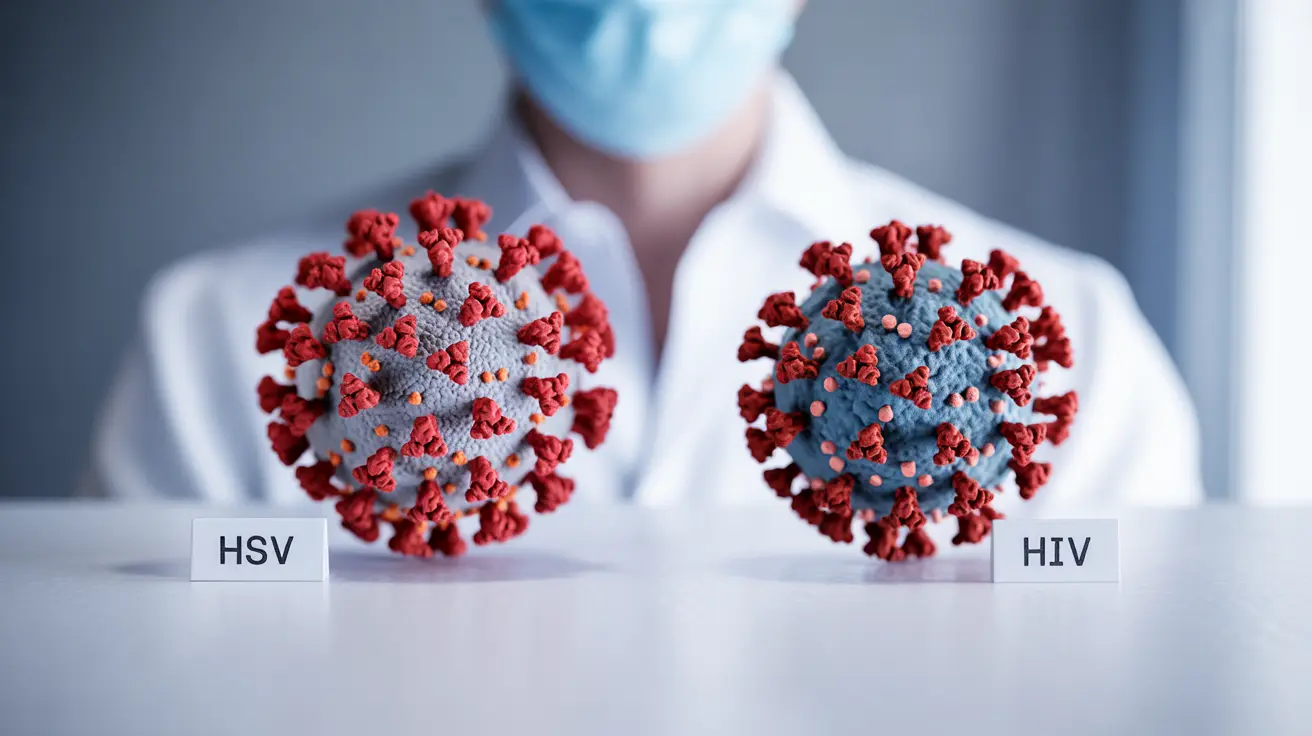Living with or understanding sexually transmitted infections (STIs) requires accurate, comprehensive information. While both herpes and HIV are viral infections that can be transmitted sexually, they are distinctly different conditions with varying impacts on health, treatment approaches, and long-term outcomes.
This article explores the crucial differences between herpes and HIV, their relationship to each other, and essential information about prevention and treatment options. Understanding these distinctions is vital for both healthcare and personal decision-making.
Key Differences Between Herpes and HIV
Herpes and HIV are fundamentally different viral infections, each with distinct characteristics and health implications:
Virus Type and Effects
Herpes is caused by the herpes simplex virus (HSV-1 or HSV-2) and primarily affects the skin and mucous membranes. HIV (Human Immunodeficiency Virus) targets the immune system itself, specifically CD4 cells, gradually weakening the body's ability to fight infections.
Symptoms and Manifestation
Herpes typically presents as recurring outbreaks of painful blisters or sores, usually around the mouth (oral herpes) or genital area (genital herpes). HIV symptoms can be more varied and systemic, including fever, fatigue, swollen lymph nodes, and other flu-like symptoms during initial infection, followed by a potentially symptom-free period.
The Connection Between Herpes and HIV
Having herpes can significantly impact HIV risk and transmission in several ways:
Increased Vulnerability
Active herpes outbreaks create open sores that can serve as entry points for HIV, making transmission more likely. Additionally, the immune response to herpes can increase the concentration of cells that HIV targets, raising infection risk even when no visible sores are present.
Transmission Risk Factors
The presence of herpes can increase HIV transmission risk by 2-3 times. This risk is heightened during active outbreaks but exists even during periods of no visible symptoms due to viral shedding.
Prevention Strategies and Treatment Options
Preventing Transmission
Several effective strategies can help prevent the transmission of both infections:
- Regular use of barrier methods during sexual activity
- Consistent medication adherence for those with either condition
- Regular testing and open communication with healthcare providers
- Avoiding sexual contact during active herpes outbreaks
Available Treatments
While neither condition has a cure, both have effective treatment options:
- Herpes: Antiviral medications can reduce outbreak frequency and severity
- HIV: Antiretroviral therapy (ART) can suppress viral load to undetectable levels
- Combined approach: Managing both conditions requires coordinated care
Living with Both Conditions
Understanding how to manage both conditions simultaneously is crucial for maintaining health and preventing transmission to others. Regular medical care, medication adherence, and lifestyle modifications play vital roles in successful management.
Frequently Asked Questions
1. What are the key differences between herpes and HIV in terms of symptoms and transmission? Herpes causes localized outbreaks of sores and blisters, while HIV affects the entire immune system. Herpes spreads through direct contact with affected areas, while HIV transmits through blood, sexual fluids, and breast milk.
2. How does a person with herpes increase their risk of acquiring HIV? Herpes creates open sores that provide entry points for HIV and increases the concentration of cells that HIV targets, potentially doubling or tripling infection risk.
3. What are the best ways to prevent the transmission of HIV when someone in the relationship has herpes? Use barrier protection consistently, adhere to prescribed medications, avoid sexual contact during outbreaks, and maintain regular medical check-ups and open communication with healthcare providers.
4. Are there any treatments or cures available for both herpes and HIV? While neither condition has a cure, both have effective treatments. Herpes can be managed with antiviral medications, and HIV can be controlled with antiretroviral therapy (ART).
5. How does having an undetectable HIV viral load affect the risk of transmitting HIV to others when you also have herpes? An undetectable HIV viral load significantly reduces HIV transmission risk. However, having active herpes outbreaks can potentially increase transmission risk, making it important to maintain both conditions' treatment regimens.




